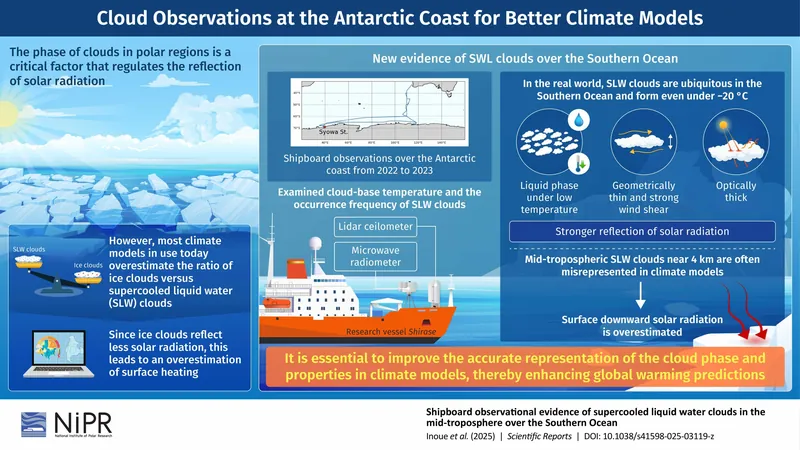
Groundbreaking Antarctic Study Unveils Secrets of Clouds That Could Transform Climate Models
2025-06-10
Author: Yu
Climate modeling is at the forefront of understanding our planet's future, playing a crucial role in predicting phenomena like global warming, sea level rise, and extreme weather. These advanced computer simulations are not just academic tools; they shape our responses to the environmental challenges of tomorrow.
Yet, the validity of these models rests heavily on their ability to replicate the intricate behaviors of Earth's atmosphere—especially when it comes to clouds. In polar regions, the stakes are higher, as even minor changes in cloud characteristics can lead to significant impacts, such as accelerated ice sheet melting and rising seas.
A significant hurdle remains: current models often misjudge the dynamics of ice clouds, overestimating their presence while neglecting supercooled liquid water (SLW) clouds. This miscalculation skews the models' predictions, leading to overinflated estimates of surface heating and creating considerable uncertainty in climate forecasts.
To tackle this pressing issue, a team of researchers including Professor Jun Inoue and Assistant Professor Kazutoshi Sato from Japan's National Institute of Polar Research embarked on an ambitious four-month study in the Antarctic Southern Ocean. Their groundbreaking findings, published in Scientific Reports, reveal critical insights into SLW clouds that could reshape climate modeling.
Setting sail on the research vessel Shirase from December 2022 to March 2023, the team employed advanced technologies such as a lidar ceilometer and a microwave radiometer. These instruments provided them with valuable data on cloud height, phase, and temperature, crucial for understanding cloud behavior.
"The ceilometer monitors the state of clouds at their base, while the microwave radiometer assesses the corresponding air temperature," explains Prof. Inoue. "This allows us to estimate how cloud base temperature affects the frequency of SLW clouds."
Their meticulous observations revealed that SLW clouds dominate the mid-troposphere, comprising an astonishing 95% of the observed clouds, even at frigid temperatures below -25 °C. These clouds are crucial, as they reflect substantial shortwave solar radiation.
Moreover, the research highlighted that the common misrepresentation of these mid-tropospheric clouds in climate models contributes to an overestimation of solar radiation reaching Earth's surface.
Inoue stated, "Our findings challenge prior assumptions and offer pathways for refining existing models, particularly their treatment of SLW clouds." The study also uncovered that local atmospheric circulation keeps SLW clouds stable during calm weather, underscoring their importance in regional energy dynamics.
The implications of this groundbreaking research are far-reaching. A clearer understanding of SLW clouds will allow scientists to correct long-standing discrepancies in climate models, leading to more precise predictions about ice sheet melt, rising sea levels, and regional climate variations that could impact billions globally.
As researchers continue to enhance these vital tools, this Antarctic study stands as a pivotal leap toward more reliable climate forecasts.

 Brasil (PT)
Brasil (PT)
 Canada (EN)
Canada (EN)
 Chile (ES)
Chile (ES)
 Česko (CS)
Česko (CS)
 대한민국 (KO)
대한민국 (KO)
 España (ES)
España (ES)
 France (FR)
France (FR)
 Hong Kong (EN)
Hong Kong (EN)
 Italia (IT)
Italia (IT)
 日本 (JA)
日本 (JA)
 Magyarország (HU)
Magyarország (HU)
 Norge (NO)
Norge (NO)
 Polska (PL)
Polska (PL)
 Schweiz (DE)
Schweiz (DE)
 Singapore (EN)
Singapore (EN)
 Sverige (SV)
Sverige (SV)
 Suomi (FI)
Suomi (FI)
 Türkiye (TR)
Türkiye (TR)
 الإمارات العربية المتحدة (AR)
الإمارات العربية المتحدة (AR)